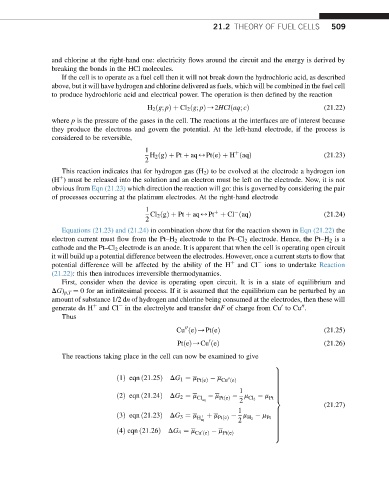Page 516 - Advanced thermodynamics for engineers
P. 516
21.2 THEORY OF FUEL CELLS 509
and chlorine at the right-hand one: electricity flows around the circuit and the energy is derived by
breaking the bonds in the HCl molecules.
If the cell is to operate as a fuel cell then it will not break down the hydrochloric acid, as described
above, but it will have hydrogen and chlorine delivered as fuels, which will be combined in the fuel cell
to produce hydrochloric acid and electrical power. The operation is then defined by the reaction
H 2 ðg; pÞþ Cl 2 ðg; pÞ/2HClðaq; cÞ (21.22)
where p is the pressure of the gases in the cell. The reactions at the interfaces are of interest because
they produce the electrons and govern the potential. At the left-hand electrode, if the process is
considered to be reversible,
1
þ
H 2 ðgÞþ Pt þ aq4PtðeÞþ H ðaqÞ (21.23)
2
This reaction indicates that for hydrogen gas (H 2 ) to be evolved at the electrode a hydrogen ion
(H ) must be released into the solution and an electron must be left on the electrode. Now, it is not
þ
obvious from Eqn (21.23) which direction the reaction will go: this is governed by considering the pair
of processes occurring at the platinum electrodes. At the right-hand electrode
1
þ
Cl 2 ðgÞþ Pt þ aq4Pt þ Cl ðaqÞ (21.24)
2
Equations (21.23) and (21.24) in combination show that for the reaction shown in Eqn (21.22) the
electron current must flow from the Pt–H 2 electrode to the Pt–Cl 2 electrode. Hence, the Pt–H 2 is a
cathode and the Pt–Cl 2 electrode is an anode. It is apparent that when the cell is operating open circuit
it will build up a potential difference between the electrodes. However, once a current starts to flow that
potential difference will be affected by the ability of the H and Cl ions to undertake Reaction
þ
(21.22): this then introduces irreversible thermodynamics.
First, consider when the device is operating open circuit. It is in a state of equilibrium and
DG) p,T ¼ 0 for an infinitesimal process. If it is assumed that the equilibrium can be perturbed by an
amount of substance 1/2 dn of hydrogen and chlorine being consumed at the electrodes, then these will
generate dn H and Cl in the electrolyte and transfer dnF of charge from Cu to Cu .
þ
00
0
Thus
00
Cu ðeÞ/PtðeÞ (21.25)
0
PtðeÞ/Cu ðeÞ (21.26)
The reactions taking place in the cell can now be examined to give
9
>
>
ð1Þ eqn ð21:25Þ DG 1 ¼ m m 00 >
PtðeÞ Cu ðeÞ >
>
>
>
1 >
>
ð2Þ eqn ð21:24Þ DG 2 ¼ m Cl m PtðeÞ m Cl 2 m >
>
>
2
aq
Pt =
(21.27)
1 >
ð3Þ eqn ð21:23Þ DG 3 ¼ m H þ þ m PtðeÞ m H 2 m Pt >
>
>
2
aq
>
>
>
>
ð4Þ eqn ð21:26Þ DG 4 ¼ m 0 m >
>
Cu ðeÞ PtðeÞ >
>
;

